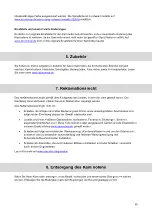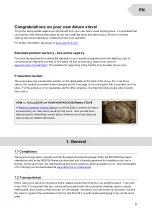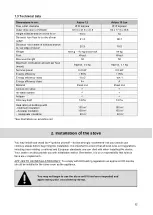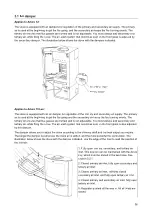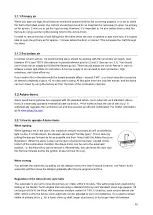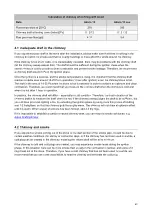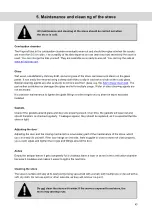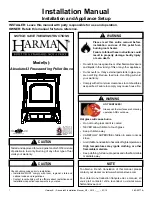
40
stoking), adjust the screw on the front of the control bracket using a small allen key. If the screw is turned to
the right, the closing time is increased, and if turned to the left, the closing time is reduced.
3.3 How should I use my wood burning stove?
The wood burning stove is intended for
intermittent
combustion. This means that each stoking should burn
down to embers before new logs are added. Always respect the MAX-load line which marks the limit for the
amount of wood.
You can regulate the effect/heat output with the fuel. Burning small logs provides more powerful combustion
than burning large logs. The ideal heat output is reached by burning approx. 1.5 kg wood per hour.
If you experience problems lighting the fire or the fire dies after a short time, it can be due to the following
reasons:
•
The firewood is not dry enough. The firewood should have a moisture content of max. 18%.
•
There is a negative pressure in the house. See section 2.5.
•
The smoke outlet from the outside may be blocked from sooth. This can occur after chimney
sweeping. Control the smoke outlet.
•
The used amount of wood may have been too small. This results in a too little and too cold layer of
embers which cannot light the new wood.
3.4 The first time a fire is lit
The wood burning stove is packed in recycling packaging. The wood from the packaging can be sawed into
smaller pieces and used the first few times a fire is lit. The plastic packaging must be disposed according to
national rules regarding disposal of waste.
During transportation, it may happen that the baffle plate in steel falls out of place. Therefore, before using
the stove, please make sure that the baffle plate is properly placed (on the hooks or fastened to the bolts
depending on the model) for optimum combustion and preventing soot on the glass.
The first few times the wood burning stove is used, there may be some smoke and unpleasant odours from
the wood burning stove, which is normal. This is caused by the heat-resistant paint hardening. Make sure
there is sufficient ventilation during this stage. It is also important not to let the fire burn too fiercely the first 2-
3 times, so that the steel has time to expand slowly.
You should also be aware that the stove may make some clicking sounds as it heats up and cools down
–
like pouring boiling water into a sink. These are caused by the great differences in temperature to which the
materials are being exposed.
If you overload the wood burning stove and burn more than the recommended
amount of wood per hour (see section 1.3), there is a risk that the surface of the
stove will become discoloured and eventually fall off. The stove can be
resurfaced.
During the first firing, which should be carried out using approximately 1 kg
of wood, the door must be left slightly open and must not be closed until the
stove is cold. This is to prevent the gaskets sticking to the stove.





